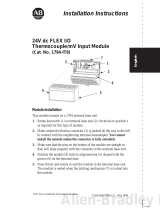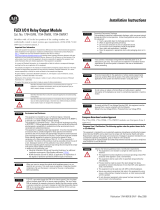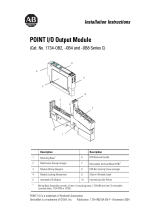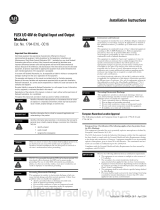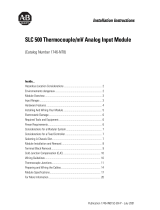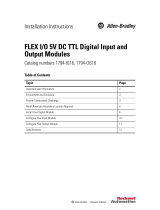La page est en cours de chargement...

Install Guide
Publication 0100153-07 Rev. A (1794sc-IRT8I) February 2023
1794sc-IRT8I
Install Guide
Important User Information
Solid-state equipment has operational characteristics differing
from those of electromechanical equipment. Safety Guidelines for
the Application, Installation, and Maintenance of Solid-State
Controls (Publication SGI-1.1 available from your local Rockwell
Automation sales office or online at
https://literature.rockwellautomation.com) describes some
important differences between solid-state equipment and hard-
wired electromechanical devices. Because of this difference, and
also because of the wide variety of uses for solid-state equipment,
all persons responsible for applying this equipment must satisfy
themselves that each intended application of this equipment is
acceptable.
In no event will Spectrum Controls, Inc. be responsible or liable for
indirect or consequential damages resulting from the use or
application of this equipment.
The examples and diagrams in this manual are included solely for
illustrative purposes. Because of the many variables and
requirements associated with any particular installation, Spectrum
Controls, Inc. cannot assume responsibility or liability for actual
use based on the examples and diagrams.
No patent liability is assumed by Spectrum Controls, Inc., with
respect to use of information, circuits, equipment, or software
described in this manual.
Reproduction of the contents of this manual, in whole or in part,
without written permission of Spectrum Controls, Inc., is
prohibited.
Throughout this manual we use notes to make you aware of safety
considerations.
WARNING
Identifies information about practices or
circumstances that can cause an explosion
in a hazardous environment, which may lead
to personal injury or death, property
damage, or economic loss.
NOTE
Identifies information that is critical for
successful application and understanding of
the product.
ATTENTION
Identifies information about practices or
circumstances that can lead to personal
injury or death, property damage, or
economic loss. Attentions help you identify a
hazard, avoid a hazard, and recognize the
consequences.
ATTENTION
Environment and Enclosure
This equipment is intended for use in a Pollution
Degree 2 industrial environment, in overvoltage
Category II applications (as defined in EN
publication 60664-1), at altitudes up to 2000 m
(6562 ft) without derating. This equipment is
considered Group 1, Class A industrial equipment
according to EN/CISPR Publication 11. Without
appropriate precautions, there may be potential
difficulties ensuring electromagnetic compatibility in
other environments due to conducted as well as
radiated disturbance. This equipment is supplied as
open-type equipment. It must be mounted within an
enclosure that is suitably designed for those
specific environmental conditions that will be
present and appropriately designed to prevent
personal injury resulting from accessibility to live
parts. The enclosure must have suitable flame-
retardant properties to prevent or minimize the
spread of flame, complying with a flame spread
rating of 5 VA, V2, V1, V0 (or equivalent) if non-
metallic. The interior of the enclosure must be
accessible only by the use of a tool. Subsequent
sections of this publication may contain additional
information regarding specific enclosure type
ratings that are required to comply with certain
product safety certifications. Besides this
publication, see: • Industrial Automation Wiring and
Grounding Guidelines, for additional installation
requirements, Allen-Bradley publication 1770-4.1. •
NEMA Standards publication 250 and EN
publication 60529, as applicable, for explanations
of the degrees of protection provided by different
types of enclosure.
WARNING
If you insert or remove the module while backplane
power is on, an electrical arc can occur. This could
cause an explosion in hazardous location
installations. Be sure that power is removed or the
area is nonhazardous before proceeding.
ATTENTION
The FLEX I/O system is grounded through the DIN
rail to chassis ground. Use zinc-plated, yellow-
chromate steel DIN rail to assure proper
grounding. The use of other DIN rail materials
(such as aluminum or plastic) that can corrode,
oxidize, or are poor conductors, can result in
improper or intermittent grounding. Secure the DIN
rail to mounting surface approximately every 200
mm and use end-anchors appropriately.
WARNING
If you connect or disconnect wiring while the field-
side power is on, an electrical arc can occur. This
could cause an explosion in hazardous location
installations. Be sure that power is removed or the
area is nonhazardous before proceeding.
WARNING
Listed only when used with Listed Allen-Bradley
Cat. NO. 1794-TB3(G) terminal base or equivalent.
This device is intended for use with A-B Type 1794
Flex-I/O programmable controller system.
AVERTISSEMENT
Répertorié uniquement lorsqu'il est utilisé avec une
base terminale Allen-Bradley Cat. n° 1794-TB3(G)
ou l'équivalent. Cet appareil est destiné à être
utilisé avec le système de contrôleurs
programmables A-B Type 1794 Flex-I/O.
WARNUNG
Gelistet nur bei Verwendung mit gelisteter Allen-
Bradley Kat. Nr. 1794-TB3(G)-Terminal-Basis oder
entsprechender Ausrüstung. Diese Vorrichtung ist
zur Verwendung mit dem Typ A-B 1794 Flex-E/A-
programmierbaren Steuersystem vorgesehen.
AVVERTENZE
In elenco solo se utilizzato con morsettiera Allen-
Bradley cat. n. 1794-TB3(G) elencata o
equivalente. Questo dispositivo è destinato ad
essere usato con il sistema controllore
programmabile tipo A-B 1794 Flex I/O.
ADVERTENCIA
Sólo se indica cuando se utiliza con el bloque de
terminales Allen-Bradley con el n.° de categoría
1794-TB3(G) o uno equivalente. Este dispositivo
está diseñado para usarse con un sistema
controlador programable 1794 Flex-I/O de tipo A-
B.
警告
仅与 Allen-Bradley 品牌的 Cat.NO.1794-TB3(G) 端
子座或同等产品一起使用时列出。本设备旨在与 A-
B 型 1794 Flex-I/O 可编程控制器系统配合使用
ATTENTION
Prevent Electrostatic Discharge
This equipment is sensitive to electrostatic
discharge, which can cause internal damage and
affect normal operation. Follow these guidelines
when you handle this equipment:
Touch a grounded object to discharge potential
static.
Wear an approved grounding wrist strap.
Do not touch connectors or pins on component
boards.
Do not touch circuit components inside the
equipment.
Use a static-safe workstation, if available.
Store the equipment in appropriate static-safe
packaging when not in use.
North American Hazardous Location Approval
WARNING
EXPLOSION HAZARD
• Do not disconnect equipment unless power has
been removed or the area is known to be
nonhazardous.
• Do not disconnect connections to this
equipment unless power has been removed or
the area is known to be nonhazardous. Secure
any external connections that mate to this
equipment by using screws, sliding latches,
threaded connectors, or other means provided
with this product.
• Substitution of components may impair
suitability for Class I, Division 2.
If this product contains batteries, they must only be
changed in an area known to be nonhazardous.
AVERTISSEMENT
RISQUE D'EXPLOSION
• Ne pas débrancher l'équipement tant que
l'alimentation n'a pas été coupée ou que la zone
n'est pas considérée comme sans danger.
• Ne pas débrancher les connexions à
l'équipement tant que l'alimentation n'a pas été
coupée ou que la zone n'est pas considérée
comme sans danger. Sécuriser toutes les
connexions externes avec cet équipement en
utilisant des vis, des loquets coulissants, des
connecteurs filetés ou tout autre moyen fourni
avec ce produit.
• La substitution de composants peut nuire à
l'adéquation à la classe I, division 2.
• Si ce produit contient des piles, celles-ci ne
doivent être remplacées que dans une zone
réputée non dangereuse.
WARNUNG
EXPLOSIONSGEFAHR
• Gerät erst trennen, wenn die Stromversorgung
getrennt wurde oder bekannt ist, dass der
Bereich sicher ist.
• Verbindungen mit dem Gerät erst trennen,
wenn die Stromversorgung getrennt wurde oder
bekannt ist, dass der Bereich sicher ist. Alle
externen Verbindungen mit diesem Gerät mit
Schrauben, Schieberiegeln, Gewindeverbindern
oder anderen mit diesem Produkt gelieferten
Mitteln sichern.
• Der Austausch von Bauteilen kann die Eignung
für Klasse I, Abteilung 2 beeinträchtigen.
• Wenn dieses Produkt Batterien enthält, dürfen
diese nur in einem als sicher bekannten Bereich
getauscht werden.
ATTENZIONE
PERICOLO DI ESPLOSIONE
• Non scollegare l’apparecchiatura se
l’alimentazione non è stata rimossa o a meno
che non sia risaputo che l’area non è
pericolosa.
• Non scollegare le connessioni
dell’apparecchiatura se l’alimentazione non è
stata rimossa o a meno che non sia risaputo
che l’area non è pericolosa. Fissare eventuali
connessioni esterne che combaciano con
questa apparecchiatura utilizzando viti, fermi
scorrevoli, connettori filettati o altri mezzi forniti
con questo prodotto.
• La sostituzione dei componenti può
compromettere l’idoneità alla Classe I, Divisione
2.
• Se questo prodotto contiene batterie, devono
essere sostituite esclusivamente in un’area nota
per non essere pericolosa.
ADVERTENCIA
RIESGO DE EXPLOSIÓN
• No desconecte el equipo a menos que se haya
cortado la electricidad o que se sepa que la zona
no es peligrosa.
• No desconecte los cables de este equipo a
menos que se haya cortado la electricidad o que
se sepa que la zona no es peligrosa. Asegure
cualquier conexión externa que se acople a este
equipo con tornillos, pestillos, conectores
roscados u otros medios suministrados con este
producto.
• La sustitución de los componentes puede afectar
a la compatibilidad con la clase I, división 2.
• Si este producto contiene baterías, sólo se
deben cambiar en una zona que se sepa que no
es peligrosa.
警告
爆炸危险
• 不要断开设备连接,除非已断电或已知该区域无
危险。
• 不要断开与本设备的连接,除非已断电或已知该
区域无危险。使用螺钉、滑动闩锁、螺纹连接器
或本产品随附的其他工具来固定与本设备匹配的
所有外部连接。
• 替换组件可能会影响 I 类 2 部分的适用性。
• 如果本产品含有电池,则只能在已知无危险的区
域更换电池。
WARNING
Special Conditions for Safe Use
• This equipment shall be mounted in an ATEX
Zone 2 certified enclosure with a minimum
ingress protection rating of at least IP54 (in
accordance with EN 60079-0) and used in an
environment of not more than Pollution Degree 2
(as defined in EN 60664-1) when applied in Zone
2 environments. The enclosure must be
accessible only by the use of a tool.
• This equipment shall be used within its specified
ratings defined by Rockwell Automation.
• Provision shall be made to prevent the rated
voltage from being exceeded by transient
disturbances of more than 140% of the peak
rated voltage when applied in Zone 2
environments.
• Models 1794sc-IF8IU and 1794sc-IRT8I are to
be used with an Allen-Bradley 1794-TB3G or
1794-TB3GS terminal base.
AVERTISSEMENT
Conditions spéciales pour une utilisation en
toute sécurité
• Cet équipement doit être monté dans une
enceinte certifiée ATEX zone 2 avec un indice de
protection minimum de IP54 (conformément à la
norme EN 60079-0) et utilisé dans un
environnement ne dépassant pas le degré de
pollution 2 (tel que défini dans la norme EN
60664-1) lorsqu'il est appliqué dans des
environnements de zone 2. L'enceinte ne doit
être accessible qu’au moyen d’un outil.
• Cet équipement doit être utilisé dans les limites
de ses caractéristiques définies par Rockwell
Automation.
• Des dispositions doivent être prises pour éviter
que la tension nominale ne soit dépassée par
des perturbations transitoires supérieures à 140
% de la tension nominale de crête lorsqu'elle est
appliquée dans des environnements de zone 2.
• Les modèles 1794sc-IF8IU et 1794sc-IRT8I
doivent être utilisés avec une base terminale
Allen-Bradley 1794-TB3G ou 1794-TB3GS.
WARNUNG
Sonderbedingungen zur sicheren Verwendung
• Dieses Gerät ist in einem nach ATEX-Zone 2
zertifizierten Gehäuse mit Mindestschutzklasse
IP54 (gemäß EN 60079-0) gegen Eindringen zu
montieren und bei Anwendung in Umgebungen
der Zone 2 und maximalem
Verschmutzungsgrad 2 (wie in EN 60664-1
definiert) zu verwenden. Das Gehäuse darf nur
mit einem Werkzeug zugänglich sein.
• Dieses Gerät ist innerhalb seiner von Rockwell
Automation festgelegten Nennwerte zu
betreiben.
• Es sind Vorkehrungen zu treffen, um das
Übersteigen der Nennspannung durch transiente
Störungen von mehr als 140 % der
Spitzennennspannung in Umgebungen der Zone
2 zu verhindern.
• Die Modelle 1794sc-IF8IU und 1794sc-IRT8I
sind in Kombination mit einer Allen-Bradley
1794-TB3G- oder 1794-TB3GS-Terminal-Basis
zu verwenden.

Install Guide
Publication 0100153-07 Rev. A (1794sc-IRT8I) February 2023
ATTENZIONE
Condizioni speciali per un utilizzo sicuro
• Questa apparecchiatura deve essere montata in
una custodia certificata ATEX Zona 2 con un
grado di protezione minima di ingresso di almeno
IP54 (conforme a EN 60079-0) ed utilizzata in un
ambiente con un grado di inquinamento non
superiore a 2 (secondo la definizione contenuta
in EN 60664-1) se installata in ambienti di Zona
2. La custodia deve essere accessibile solo con
l'uso di uno strumento.
• Questa apparecchiatura deve essere utilizzata
nei limiti delle proprie potenze nominali
specifiche definite da Rockwell Automation.
• È necessario fare in modo di evitare che la
tensione nominale venga superata di oltre il
140% della tensione nominale di picco da
disturbi transitori se installata in ambienti di Zona
2.
• I modelli 1794sc-IF8IU e 1794sc-IRT8I devono
essere utilizzati con morsettiera Allen-Bradley
1794-TB3G o 1794-TB3GS.
警告
安全使用的特殊条件
• 该系统应安装在GB 3836.1所定义的最低防护等级
至少为IP54的外壳中,并在不超过GB / T 16935.1
。定义的污染等级2的环境中使用。 外壳必须具有
只能使用工具才能触及的门或盖。
• 本设备应在 Rockwell Automation 定义的额定值
范围内使用。
• 当在 Zone 2 环境中使用时,应采取措施防止因超
过最大额定电压峰值 140% 的瞬变干扰而超过规
定额定电压。
• 型号 1794sc-IF8IU 和 1794sc-IRT8I 需要与
Allen-Bradley 1794-TB3G 或 1794-TB3GS 端子
座同时使用。
Install Your IRT8I Input Module
ATTENTION
During mounting of all devices, be sure that all
debris (for example, metal chips or wire strands) is
kept from falling into the module. Debris that falls
into the module could cause damage on power up.
The module mounts on a 1794-TB3G or 1794-TB3GS terminal base.
1. Rotate the key switch (1) on the terminal base (2) clockwise to position 3
as required for this type of module.
2. Make certain the Flexbus connector (3) is pushed all the way to the left to
connect with the neighboring terminal base/adapter. You cannot install
the module unless the connector is fully extended.
3. Make sure the pins on the bottom of the module are straight so they will
align properly with the connector in the terminal base.
WARNING
If you remove or insert the module while the
backplane power is on, an electrical arc can
occur. This could cause an explosion in
hazardous location installations. Be sure that
power is removed or the area is nonhazardous
before proceeding.
4. Position the module (4) with its alignment bar (5) aligned with the groove
(6) on the terminal base.
5. Press firmly and evenly to seat the module in the terminal base unit. The
module is seated when the latching mechanism (7) is locked into the
module.
Connect Wiring for the 1794-TB3G or 1794-TB3GS Terminal Base
1. Connect individual input wiring and associated signal returns to numbered
terminals on the 0…15 row (A) and the 16…33 row (B) as indicated in the
table.
2. Use Belden 8761 cable for mV signal wiring, or the appropriate
thermocouple wire for your thermocouples.
3. Signal wiring shields can be connected to terminals 16 or 33 on row (B) or
terminals 40…45 on row (C).
Connect the +VDC power lead to terminal 34 on the 34…51 row (C).
4. Connect the -VDC common (return-) to terminal 35 on the 34…51 row
(C).
ATTENTION
To reduce susceptibility to noise, power analog
modules and digital modules from separate power
supplies. Do not exceed a length of 3 m (9.8 ft) for
DC power cabling.
ATTENTION
Do not daisy-chain power or ground from this
terminal base unit to any AC or DC digital module
terminal base units.
5. If daisy-chaining power to the next terminal base unit, connect a jumper
from terminal 50 (+VDC) on this base unit to +V terminal on the next
terminal base unit.
Connect a jumper from terminal 51 (-VDC common) to the - VDC
common terminal on the next terminal base unit.
6. If using cold junction compensators, make these connections as shown in
the CJC Sensor chart below.
Identify RTD Wire Pairs
If the RTD wires are color-coded, the wires that are the same color are
connected together. If the wires are not color-coded, use an ohmmeter to
determine the pairs as explained below.
How to Connect a 3-Wire RTD
If the 3-wire RTD wires are all different colors, use an ohmmeter to determine
which leads are connected together. Either lead of the pair can be the
compensation lead. Attach one lead of the pair to terminal L and the other to +.
Attach the single lead to -.Refer to the following table.
Wire Connections for the Isolated Universal
Input Module
Input
CJC Sensor
+
Chassis
Ground
-
CJC
Tail
1
CJC1
C37
C38
C39
A1
CJC2
C-46
C-47
C-48
B31
1Terminals 37, 38, and 39, and 46, 47, and 48 are for cold
junction compensation (with 38 and 47 chassis GND).
Connect
the tail of CJC 1 to terminal 1 and CJC2 to terminal 31,
if
channels 0…3 or 0…7
are configured for thermocouples.
The power supply in the current loop to the current inputs (I/O)
of the devices may only be an Isolated Secondary Limited
Voltage, Class 2, or Limited Voltage/Current power supply.
Terminal Base Unit Wiring Connections
Channel
Number
1794-TB3G and 1794-TB3GS Terminal Base Units
Signal
Return
(R)
Input +
(IN+)
Input
(-)
I Return
(-)
0
A-0
A-1
A-2
A-3
1 A-4 A-5 A-6 A-7
2
A-8
A-9
A-10
A-11
3 A-12 A-13 A-14 A-15
4
B-17
B-18
B-19
B-20
5 B-21 B-22 B-23 B-24
6
B-25
B-26
B-27
B-28
7 B-29 B-30 B-31 B-32
1Terminals 16, 33, and 40…45 are chassis ground.
Example of RTD/Resistance Wiring to a 1794-TB3G
Terminal Base Unit
Example of Thermocouple Wiring to a 1794-TB3G
Terminal Base Unit
Input Map and Configuration (EDT)
The following information is presented for experienced users
only. Refer to the user manual, publication 0300242-nn, for
complete information on programming and configuring your
module.
Input Map (Read)
Usage (16-bit words):
I:0
Channel 0 input Data.
I:1
Channel 1 input Data.
I:2
Channel 2 input Data.
I:3
Channel 3 input Data.
I:4
Channel 4 input Data.
I:5
Channel 5 input Data.
I:6
Channel 6 input Data.
I:7
Channel 7 input Data.
15
14
13
12
11
10
9
8
7
6
5
4
3
2
1
0
S:0
OverRange (CH0/Bit 8, CH1/Bit 9, …)
UnderRange (CH0/Bit 0, CH1/Bit 1, …)
S:1
User HI Alarms (CH0/Bit8, CH1/Bit9,
…)
User LO Alarms (CH0/Bit0, CH1/Bit1, …)
S:2
Reserved
CJC
Alarm
Broken Input Alarms
S:3
Reserved
Diagnostics
CJC Alarm
Bit 9
Bit 8
CJC Alarm:
0
0
No Errors
0
1
CJC1 is broken.
1
0
CJC2 is broken.
1
1
Both CJC1 and CJC2 are broken.
EDT Configuration Table
Usage (16 bit words):
15
14
13
12
11
10
9
8
7
6
5
4
3
2
1
0
C:0
R1
R1
F7
F6
F5
F4
R1
R1
R1
F3
F2
F1
F0
R 1
C:1
°F
Ch0
DC
Ch0
BIM
Ch0
R1
Data Format
Ch0
Input Filter
Ch0
Input Type CH0
C:2
°F
Ch1
DC
Ch1
BIM
Ch1
R1
Data Format
Ch1
Input Filter
Ch1
Input Type CH1
C:3
°F
Ch2
DC
Ch2
BIM
Ch2
R1
Data Format
Ch2
Input Filter
Ch2
Input Type CH2
C:4
°F
Ch3
DC
Ch3
BIM
Ch3
R1
Data Format
Ch3
Input Filter
Ch3
Input Type CH3
C:5
°F
Ch4
DC
Ch4
BIM
Ch4
R1
Data Format
Ch4
Input Filter
Ch4
Input Type CH4
C:6
°F
Ch5
DC
Ch5
BIM
Ch5
R1
Data Format
Ch5
Input Filter
Ch5
Input Type CH5
C:7
°F
Ch6
DC
Ch6
BIM
Ch6
R1
Data Format
Ch6
Input Filter
Ch6
Input Type CH6
C:8
°F
Ch7
DC
Ch7
BIM
Ch7
R1
Data Format
Ch7
Input Filter
Ch7
Input Type CH7
C:9
CH0 User Low Alarm Threshold
C:10
CH0 User High Alarm Threshold
C:11
CH0 User Alarm Deadband
C:12
CH1 User Low Alarm Threshold
C:13
CH1 User High Alarm Threshold
C:14
CH1 User Alarm Deadband
C:15
CH2 User Low Alarm Threshold
C:16
CH2 User High Alarm Threshold
C:17
CH2 User Alarm Deadband
C:18
CH3 User Low Alarm Threshold
C:19
CH3 User High Alarm Threshold
C:20
CH3 User Alarm Deadband
C:21
CH4 User Low Alarm Threshold
C:22
CH4 User High Alarm Threshold
C:23
CH4 User Alarm Deadband
C:24
CH5 User Low Alarm Threshold
C:25
CH5 User High Alarm Threshold
C:26
CH5 User Alarm Deadband
C:27
CH6 User Low Alarm Threshold
C:28
CH6 User High Alarm Threshold
C:29
CH6 User Alarm Deadband
C:30
CH7 User Low Alarm Threshold
C:31
CH7 User High Alarm Threshold
C:32
CH7 User Alarm Deadband
1Reserved for future expansion
F0 through F7 (Channel n Fault Mode)
State
Function
0
Disabled
1
Broken input testing enabled
Input Type
Bit 4
Bit 3
Bit 2
Bit 1
Bit 0
Range:
0
0
0
0
0
B Type Thermocouple
0
0
0
0
1
C Type Thermocouple
0
0
0
1
0
E Type Thermocouple
0
0
0
1
1
J Type Thermocouple
0
0
1
0
0
K Type Thermocouple
0
0
1
0
1
N Type Thermocouple
0
0
1
1
0
R Type Thermocouple
0
0
1
1
1
S Type Thermocouple
0
1
0
0
0
T Type Thermocouple
0
1
0
0
1
100 Ω Pt α 0.385
0
1
0
1
0
200 Ω Pt α 0.385
0
1
0
1
1
500 Ω Pt α 0.385
0
1
1
0
0
1000 Ω Pt α 0.385
0
1
1
0
1
100 Ω Pt α 0.3916
0
1
1
1
0
200 Ω Pt α 0.3916
0
1
1
1
1
500 Ω Pt α 0.3916
1
0
0
0
0
1000 Ω Pt α 0.3916
1
0
0
0
1
10 Ω Cu α 0.426
1
0
0
1
0
100 Ω Ni α 0.618
1
0
0
1
1
120 Ω Ni α 0.672
1
0
1
0
0
604 Ω NiFe α 0.518
1
0
1
0
1
R 0 to 150 Ω
1
0
1
1
0
R 0 to 1000 Ω
1
0
1
1
1
R 0 to 3000 Ω
1
1
0
0
0
±50 mV
1
1
0
0
1
±100 mV

Install Guide
Publication 0100153-07 Rev. A (1794sc-IRT8I) February 2023
Input Filter
Bit 7
Bit 6
Bit 5
ADC Filter:
0
0
0
4.17 Hz
0
0
1
10.0 Hz
0
1
0
16.7 Hz
0
1
1
19.6 Hz
1
0
0
62.0 Hz
1
0
1
470.0 Hz
1
1
0
*Unused
1
1
1
*Unused
Data Format
Bit 10
Bit9
Bit 8
Format:
0
0
0
Engineering Units
0
0
1
Engineering Units ×10
0
1
0
Raw/Proportional
Counts
0
1
1
Scaled for PID
1
0
0
Percent of Full Scale
1
0
1
1CJC EU
1
1
0
1CJC Scaled for PID
1
1
1
1CJC Percent of Full
Scale
1 If selected, the CJC format will override all ranges/formats and
report the indicated CJC value for this channel. Channel zero will
report CJC0 directly. Channel 7 will report CJC1 directly. All others
will be distributed values between CJC0 and CJC1 based on channel
position.
BIM Ch n (Broken Input Mode Channel n)
Bit 13
Bit 12
1Broken Input Mode:
0
0
Zero analog value on broken input.
0
1
Set analog value to Max scale on broken input.
1
0
Set analog value to Min scale on broken input.
1
1
Previous Value
DC Ch n (Disable CJC for Channel n)
State
Function
0
CJCs Enabled1
1
CJCs Disabled1
1This field is only used if the input type is
a thermocouple and the format is not a
CJC format. No compensation is
performed on the thermocouple when
disabled.
˚F Ch n (Temperature Units for Channel n)
State
Function
0
Degrees C
1
Degrees F
Specifications
Number of inputs
8 channels
Module Location
Cat. No. 1794-TB3G, 1794-TB3GS
Terminal Base Units
Nominal input
voltage ranges
±50 mV, ±100 mV
Supported
thermocouple
types
Type °C Range °F Range
B 300…1820 °C (572…3308 °F)
C 0…2315 °C (32…4199 °F)
E -270…1000 °C (-454…1832 °F)
J -210…1200 °C (-346…2192 °F)
K -270…1370 °C (-454…2498 °F)
N -210…1300 °C (-346…2372 °F)
R 0…1768 °C (32…3214 °F)
S 0…1768 °C (32…3214 °F)
T -270…400 °C (-454…752 °F)
Supported
RTD/Resistance
types
RTD
100 Ω Pt α = 0.385
-200…850 °C (-328…1562 °F)
200 Ω Pt α = 0.385
-200…850 °C (-328…1562 °F)
500 Ω Pt α = 0.385
-200…850 °C (-328…1562 °F)
1000 Ω Pt α = 0.385
-200…850 °C (-328…1562 °F)
100 Ω Pt α = 0.392
-200…630 °C (-328…1166 °F)
200 Ω Pt α = 0.392
-200…630 °C (-328…1166 °F)
500 Ω Pt α = 0.392
-200…630 °C (-328…1166 °F)
1000 Ω Pt α = 0.392
-200…630 °C (-328…1166 °F)
10 Ω Cu α = 0.426
-100…260 °C (-148…500 °F)
100 Ω Ni α = 0.618
-100…260 °C (-148…500 °F)
120 Ω Ni α = 0.672
-80…260 °C (-112…500 °F)
604 Ω NiFe α = 0.518
-100…200 °C (-148…392 °F)
Resistance
0…150 Ω
0…1000 Ω
0…3000 Ω
Resolution
16 bits
Data format
Engineering Units ×1
Engineering Units ×10
Raw/Proportional Counts
Scaled for PID
Percent of full scale
Input Impedance
>1 M Ω for voltage, thermocouple, RTD and resistance
inputs
Common mode
rejection
60 dB at 5 V peak-to-peak, 50…60 Hz
Isolation voltage
(continuous
voltage withstand
rating)
User power to Backplane: 24 VDC continuous
Channel to Backplane: 24 VDC continuous
Channel to Channel: 24 VDC continuous.
Channel to User power: 24 VDC continuous
Open circuit
protection
Open circuit detection bias <1 uA with ON/OFF capability
Overvoltage
capability
Voltage mode ±24 VDC continuous (ten minutes)
Cold junction
compensation
Range
-20…100 °C
Cold junction
compensator
A-B catalog number 1794-CJC2
Flexbus current
80 mA
Power dissipation
6.28 W max at 31.2 VDC
Thermal
dissipation
Max 10.2 BTU/Hr at 31.2 VDC
Key switch position
3
Accuracy Specifications
Thermocouple Accuracy
with 4.17 Hz filter
using Linearization per ITS-90
Accuracy
Limit At
25 °C
4.17 Hz
Filter
Accuracy
Limit At 0-
55 °C
4.17 Hz
Filter
Repeatability Limit
At 25
°C & 4.17 Hz
filter
Type J (-50 ˚C to 1200 ˚C):
±0.6 °C
±2.3 °C
±0.17 °C
Type J (-210 ˚C to -50 ˚C):
±0.8 °C
±3.3 °C
±0.25 °C
Type N (-80 ˚C to 1300 ˚C):
±1.0 °C
±1.5 °C
±0.3 °C
Type N (-250 ˚C to -80 ˚C):
±1.2 °C
±3.0 °C
±1.9 °C
Type T (-180 ˚C to 400 ˚C):
±1.0 °C
±1.5 °C
±0.2 °C
Type T (-270 ˚C to -180 ˚C):
±5.4 °C
±8.5 °C
±1.5 °C
Type K (-180 ˚C to 1370 ˚C):
±1.0 °C
±1.5 °C
±0.3 °C
Type K (-270 ˚C to -180 ˚C):
±7.5 °C
±11.5 °C
±3.6 °C
Type E (-130 ˚C to 1000 ˚C):
±0.5 °C
±1.5 °C
±0.1 °C
Type E (-270 ˚C to -130 ˚C):
±4.2 °C
±7.3 °C
±1.2 °C
Type C (0 ˚C to 2315 ˚C):
±1.8 °C
±3.5 °C
±0.9 °C
Type B (600 ˚C to 1800 ˚C):
±3.0 °C
±4.0 °C
±1 °C
Type B (300 ˚C to 600 ˚C):
±3.0 °C
±8.0 °C
±2 °C
Type S (140 ˚C to -1760 ˚C):
±1.7 °C
±2.6 °C
±0.55 °C
Type S (0 ˚C to 14 ˚C):
±1.7 °C
±5.0 °C
±1.0 °C
Type R (280 ˚C to -1760 ˚C):
±1.7 °C
±2.6 °C
±0.4 °C
Type R (0 ˚C to 280 ˚C):
±1.7 °C
±5.0 °C
±1.0 °C
CJC accuracy
±1.0 °C
3.0 °C
±0.8 °C
Resistance Accuracy
with 4.17 Hz filter
Accuracy
Limit At
25 °C
4.17 Hz
Filter
Accuracy
Limit At 0-
55 °C
4.17 Hz
Filter
Repeatability Limit
At 25
°C & 4.17 Hz
filter
0-150 ohms range
±0.15 ohms
±0.25 ohms
±10 milliohms
0-1000 ohms range
±1.0 ohms
±2.0 ohms
±100 milliohms
0-3000 ohms range
±1.5 ohms
±2.5 ohms
±100 milliohms
RTD Accuracy
With 4.17 Hz filters
Accuracy
Limit At
25 °C
4.17 Hz
Filter
Accuracy
Limit At 0-
55 °C
4.17 Hz
Filter
Repeatability Limit
At 25
°C & 4.17 Hz
filter
Platinum 385 (100, 200, 500
and 1000 ohms) (IEC751 1983,
Amend 2 1995; JISC 1604
1997)
±0.7 °C ±1.2 °C ±0.1 °C
Platinum 3916 (100, 200, 500
and 1000 ohms) (JISC 1604:
1981)
±0.6 °C ±1.1 °C ±0.1 °C
Nickel 618 (100 ohms) (DIN
43760 Sept. 1987)
±0.3 °C ±0.5 °C ±0.1 °C
Nickel 672(120 ohms) (DIN
43760 Sept. 1987)
±0.3 °C ±0.5 °C ±0.1 °C
Nickel-Iron (518) (MINCO
Application Aid #18, Date 5/90)
±0.4 °C ±0.7 °C ±0.1 °C
Copper 426 (10 ohms) (SAMA
RC21-4-1966)
±2.0 °C ±2.4 °C ±0.1 °C
General Specifications
Voltage range
Supply current
24 VDC nom
240 mA @ 24 VDC
Dimensions (with
module installed in
base)
H × W × D approx.
94 × 94 × 69 mm
(3.7 × 3.7 × 2.7 in.)
Environmental
Conditions
Temperature,
operating
Tamb 0 °C to 55 °C (-32 °F to 131 °F) This range applies
only to modules installed horizontally as shown:
Tamb 0 °C to 45 °C (-32 °F to 113 °F) This range
applies when modules are installed vertically. When
installed vertically, it is recommended that the power
supply be located on the top.
Temperature,
storage
–40…85 °C (–40…185 °F)
Relative humidity
IEC 60068-2-30 (Test Db, Unpackaged Damp Heat):
5…95% non-condensing
Vibration
IEC60068-2-6 (Test Fc, Operating):
5 g at 10…500 Hz
Shock
Operating
Non-operating
IEC60068-2-27 (Test Ea, Unpackaged shock):
20 g
25 g
Emissions
CISPR 11:
Group 1, Class A (with appropriate enclosure)
ESD immunity
IEC 61000-4-2:
6 kV contact discharges
8 kV air discharges
Radiated RF
immunity
IEC 61000-4-3:
10 V/m with 1 kHz sine-wave 80% AM from 30…2000
MHz
10 V/m with 200 Hz 50% Pulse 100% AM at 900 MHz
10 V/m with 200 Hz 50% Pulse 100% AM at 1890 MHz
EFT/B immunity
IEC 61000-4-4:
±2 kV at 5 kHz on signal ports
Surge transient
immunity
IEC 61000-4-5:
±2 kV line-earth (CM) on shielded ports
Conducted RF
immunity
IEC 61000-4-6:
10 V RMS with 1 kHz sine-wave 80% AM from 150
kHz…80 MHz
Enclosure type
rating
None (open-style)
Signal conductors
Thermocouple
Millivolt
Category (1)
Use appropriate shielded thermocouple wire (3)
Belden 8761 - on signal ports
Power conductors
Wire size
Category (1)
0.34…2.5 mm2 (22…12 AWG) solid or stranded copper
wire rated
at 75 °C (167 °F) or greater
1.2 mm (3/64 in.) insulation max
3 - on power ports
Terminal screw
torque for cage-
clamp terminal base
0.8 Nm (7 lb-in.)
Certifications (when
product is marked)
(2)
UL Listed for Class I, Division 2 Group A,B,C,D
Hazardous Locations, certified for U.S. and Canada. See
UL File E180101.
UL Listed Industrial Control Equipment, certified for U.S
and Canada. See UL File E140954.
Ex European Union 2014/34/EU
ATEX Directive, compliant with:
EN 60079-7:2015+A1:2018; Potentially Explosive
Atmospheres, Protection “ec” (Zone 2)
II 3 G Ex ec IIC T4 Gc
EN 60079-0:2018
Certificate UL 20 ATEX 2409X
CE European Union 2014/30/EU EMC Directive,
compliant with:
EN 61000-6-4; Industrial Emissions
EN 61326; Meas./Control/Lab., Industrial Requirements
EN 61000-6-2; Industrial Immunity
EN 61131-2; Programmable Controllers
(Clause 8, Zone A & B)
CCC
GB/T3836.1-2021, GB/T3836.3-2021
GBEx 2021312310000326
GBEx 2021312310000345
CMIM
Arrêté ministériel n° 6404-15 du 29 ramadan 1436 (16
juillet 2015)
NM EN 61131-2, NM EN 61000-6-4, NM EN 61000-6-2
(1) Use this category information for planning conductor routing as described in Industrial Automation
Wiring and Grounding Guidelines, Allen-Bradley publication 1770-4.1.
(2) For the latest up-to-date information, see the Product Certification link at www.spectrumcontrols.com
for Declarations of Conformity Certificates and other certification details.
(3) Refer to the thermocouple manufacturer for proper thermocouple extension.
1705 132nd Ave NE
Bellevue, WA 98005 USA
Tel: 425-746-9481
Fax: 425-641-9473
Email: spectrum@spectrumcontrols.com
Web: www.spectrumcontrols.com
1/3


